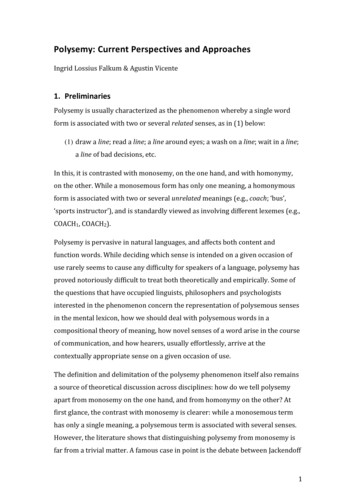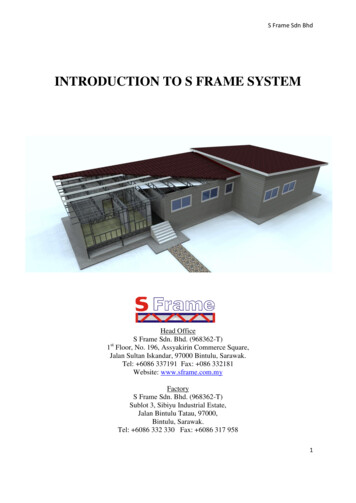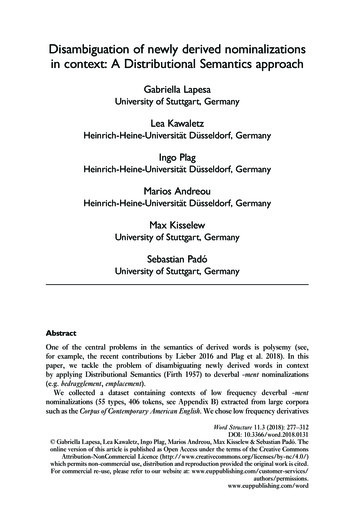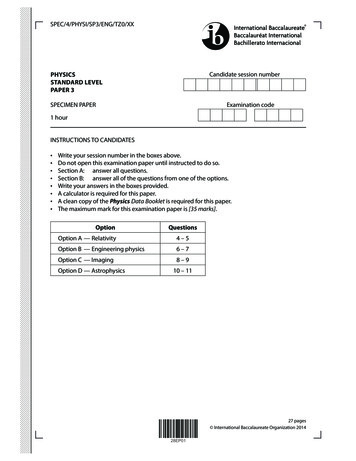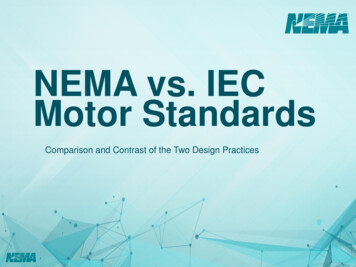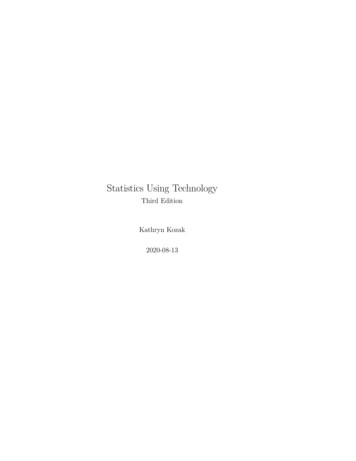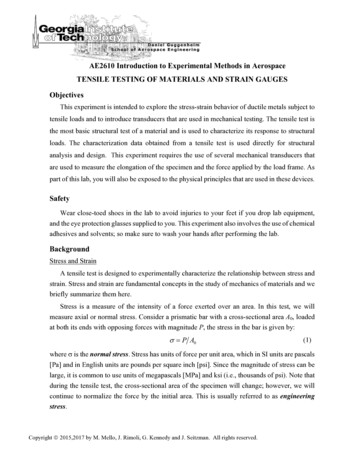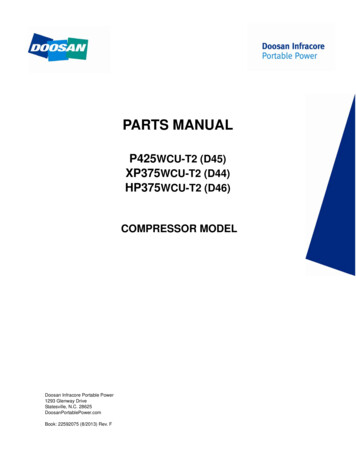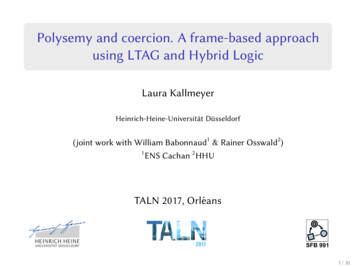
Transcription
Polysemy and coercion. A frame-based approachusing LTAG and Hybrid LogicLaura KallmeyerHeinrich-Heine-Universität Düsseldorf(joint work with William Babonnaud1 & Rainer Osswald2 )1ENS Cachan 2 HHUTALN 2017, OrléansSFB 9911 / 30
Table of contents1Introduction2Polysemy, dot objects and coercion3Further examples of coercion4Quantification and polysemous nouns5Conclusion and future work2 / 30
IntroductionOur approach to the syntax-semantics interface:Semantic composition is triggered by syntactic composition.Every meaning component is linked to some fragment of thesyntactic structure.Semantic composition is monotonic.3 / 30
IntroductionOur approach to the syntax-semantics interface:Semantic composition is triggered by syntactic composition.Every meaning component is linked to some fragment of thesyntactic structure.Semantic composition is monotonic.Particularly challenging: coercion phenomena, where meaning“changes” in an apparently non-monotonic way, often explained bythe presence of some hidden operator.(1) a. Mary began the book.b. John left the party.c. Mary mastered the heavy book on magic.3 / 30
IntroductionProposal: Frames as a way to represent rich lexical content.Semantic frames are commonly depicted as graphs withlabeled nodes and edges, where nodes correspond to entities(individuals, events, . . . ) and edges to functional (or non-functional)relations between these onpathpart-ofendpwalkingpathregionregion4 / 30
IntroductionProposal: Frames as a way to represent rich lexical content.Semantic frames are commonly depicted as graphs withlabeled nodes and edges, where nodes correspond to entities(individuals, events, . . . ) and edges to functional (or non-functional)relations between these onpathpart-ofendpwalkingpathregionregionFrames in this sense can be formalized as feature structureswith types and relations (e.g. Kallmeyer & Osswald, 2013).4 / 30
IntroductionIn combination with frames, we need a syntactic frameworkthat allows to represent constructions. Our choice: LexicalizedTree Adjoining Grammars (LTAG).5 / 30
IntroductionIn combination with frames, we need a syntactic frameworkthat allows to represent constructions. Our choice: LexicalizedTree Adjoining Grammars (LTAG).Furthermore, we need the possibility of underspecification andquantification concerning the way we formulate constraints onframes. Our choice: Hybrid Logic (HL) and underspecificationin the sense of hole semantics (Kallmeyer et al., 2016).5 / 30
Introduction(2) John ate pizza.SVPNP[i 1 ]VNP[i 2 ,p l0 ]‘ate’6 / 30
Introduction(2) John ate pizza.SVPNP[i 1 ]VNP[i 2 ,p l0 ]‘ate’ eating agent theme 1 2 6 / 30
Introduction(2) John ate pizza.SVPNP[i 1 ]V‘ate’NP[i 2 ,p l0 ]l0 E(eating ⟨agent⟩ 1 ⟨theme⟩ 2 )6 / 30
Introduction(2) John ate pizza.NP[i i]SVPNP[i 1 ]‘John’V person i name John ‘ate’NP[i 2 ,p l0 ]l0 E(eating ⟨agent⟩ 1 ⟨theme⟩ 2 )6 / 30
Introduction(2) John ate pizza.NP[i i]SVPNP[i 1 ]‘John’V@i (person ⟨name⟩John)‘ate’NP[i 2 ,p l0 ]l0 E(eating ⟨agent⟩ 1 ⟨theme⟩ 2 )6 / 30
Introduction(2) John ate pizza.NP[i i]SNP[i x, p 3 ]VPNP[i 1 ]‘pizza’‘John’@i (person ⟨name⟩John)V‘ate’NP[i 2 ,p l0 ]x [pizza]l0 E(eating ⟨agent⟩ 1 ⟨theme⟩ 2 )6 / 30
Introduction(2) John ate pizza.NP[i i]SNP[i x, p 3 ]VPNP[i 1 ]‘pizza’‘John’@i (person ⟨name⟩John)V‘ate’NP[i 2 ,p l0 ]E( x.pizza 3 )l0 E(eating ⟨agent⟩ 1 ⟨theme⟩ 2 )6 / 30
Introduction(2) John ate pizza.NP[i i]SNP[i x, p 3 ]VPNP[i 1 ]‘pizza’‘John’NP[i 2 ,p l0 ]V@i (person ⟨name⟩John)‘ate’E( x.pizza 3 )l0 E(eating ⟨agent⟩ 1 ⟨theme⟩ 2 )resulting derived tree-frame pair:S@i (person ⟨name⟩John)E( x.pizza E(eating ⟨agent⟩i ⟨theme⟩x))VPNP[i i]‘John’VNP[i x,p l0 ]‘ate’‘pizza’6 / 30
Introduction(2) John ate pizza.NP[i i]SNP[i x, p 3 ]VPNP[i 1 ]‘pizza’‘John’NP[i 2 ,p l0 ]V@i (person ⟨name⟩John)‘ate’E( x.pizza 3 )l0 E(eating ⟨agent⟩ 1 ⟨theme⟩ 2 )resulting derived tree-frame pair:S@i (person ⟨name⟩John)E( x.pizza E(eating ⟨agent⟩i ⟨theme⟩x))VPNP[i i]nameagent‘John’VNP[i x,p l0 ]eatingipersonJohnxtheme‘ate’‘pizza’pizza6 / 30
IntroductionLexicalized Tree Adjoining Grammar (LTAG, Joshi & Schabes1997; Abeillé & Rambow 2000):Finite set of elementary trees.Larger trees are derived via the tree composition operationssubstitution (replacing a leaf with a new tree) and adjunction(replacing an internal node with a new tree).SSNPVPNPVPNP‘Peter’VVPAdvVP ‘ate’ NP‘Peter’VPAdv‘always’VNPNP‘ate’ ‘pizza’‘always’‘pizza’7 / 30
IntroductionComponents of the syntax semantics interface (Kallmeyer & Osswald,2013; Kallmeyer et al., 2016):Semantic representations are linked to entire elementary trees.Semantic representations: frames, expressed as typed featurestructures, or rather HL formulas that describe frames.Interface features relate nodes in the syntactic tree to nodes inthe frame graph.Composition by unification is triggered by substitution andadjunction.8 / 30
Polysemy, dot objects and coercion(3) a. The book is heavy.b. The book is interesting.phys-objinformationThe noun ‘book’ is inherently polysemous between a physical objectinterpretation and an information content interpretation (dot objectnominals, Pustejovsky, 1995, 1998).9 / 30
Polysemy, dot objects and coercion(3) a. The book is heavy.b. The book is interesting.phys-objinformationThe noun ‘book’ is inherently polysemous between a physical objectinterpretation and an information content interpretation (dot objectnominals, Pustejovsky, 1995, 1998).(4) a. John read the book.b. John read the story.c. John read the blackboard.The verb ‘read’ allows for the direct selection of the dot objectbook (4a).It also enables coercion of its complement from the typeinformation (4b) as well as from the type phys-obj (4c).9 / 30
Polysemy, dot objects and coercionSemantics of the dot object nominal ‘book’ (Babonnaud et al., 2016):Background constraints:A(book info-carrier )10 / 30
Polysemy, dot objects and coercionSemantics of the dot object nominal ‘book’ (Babonnaud et al., 2016):Background constraints:A(book info-carrier )bookbook info-carrier 10 / 30
Polysemy, dot objects and coercionSemantics of the dot object nominal ‘book’ (Babonnaud et al., 2016):Background constraints:A(book info-carrier )bookbook info-carrier A(info-carrier phys-obj ⟨content⟩information)10 / 30
Polysemy, dot objects and coercionSemantics of the dot object nominal ‘book’ (Babonnaud et al., 2016):Background constraints:A(book info-carrier )bookbook info-carrier A(info-carrier phys-obj ⟨content⟩information)info-carrier phys-objinfo-carrier informationcontent10 / 30
Polysemy, dot objects and coercionSemantics of the dot object nominal ‘book’ (Babonnaud et al., 2016):Background constraints:A(book info-carrier )bookbook info-carrier A(info-carrier phys-obj ⟨content⟩information)info-carrier phys-objinfo-carrier informationcontentThe lexical entry of ‘book’ only specifies that the wordcontributes an element of type book.By the above constraints, it follows that a book “node” is oftype info-carrier (supertype of book) and phys-obj (supertypeof info-carrier), and that it has an attribute ⟨content⟩ with avalue of type information.10 / 30
Polysemy, dot objects and coercionSemantics of ‘read’ (inspired by Pustejovsky, 1998):Reading events consist of two subevents, the action of lookingat a physical object (the perception) and the action of processingthe provided information (the comprehension).11 / 30
Polysemy, dot objects and coercionSemantics of ‘read’ (inspired by Pustejovsky, 1998):Reading events consist of two subevents, the action of lookingat a physical object (the perception) and the action of processingthe provided information (the comprehension).The two event components are linked by the (non-functional)temporal relation ordered-overlap.11 / 30
Polysemy, dot objects and coercionSemantics of ‘read’ (inspired by Pustejovsky, 1998):Reading events consist of two subevents, the action of lookingat a physical object (the perception) and the action of processingthe provided information (the comprehension).The two event components are linked by the (non-functional)temporal relation ordered-overlap.A(reading v.⟨perc-comp⟩(perception ⟨ordered-overlap⟩ v) ⟨ment-comp⟩(comprehension v))perceptionperc-compreading orderedoverlapreadingment-compcomprehension11 / 30
Polysemy, dot objects and coercionSemantics of ‘read’ (continued):The perception component has an attribute stimulus of typephys-obj and the comprehension node has an attribute contentwhose value is the information that is being read and whichcoincides with the content of the stimulus.perception gcontentcontentment-compcomprehensioninformation12 / 30
Polysemy, dot objects and coercionSemantics of ‘read’ (continued):The perception component has an attribute stimulus of typephys-obj and the comprehension node has an attribute contentwhose value is the information that is being read and whichcoincides with the content of the stimulus.perception e argument of ‘read’ can provide either the stimulus of theperception (phys-obj) or its content (information).12 / 30
Polysemy, dot objects and coercionSemantics of ‘read’ and lexical anchoring:SNP[i 1 ]VPV1agentreadingperception contentcontentment-compNP[i 2 ]ycomprehensioninformation2 x 2 y13 / 30
Polysemy, dot objects and coercionSemantics of ‘read’ and lexical anchoring:SNP[i 1 ]VPV x. y.E(reading ⟨agent⟩ 1NP[i 2 ]‘read’ ⟨perc-comp⟩⟨stimulus⟩x ⟨ment-comp⟩⟨content⟩y @x (phys-obj ⟨content⟩(information y)) (2 x 2 y))13 / 30
Polysemy, dot objects and coercionCompositional derivation of ‘John read the book’ [ (4a)]l0 x. y.E(reading ⟨agent⟩ 1 ⟨perc-comp⟩⟨stimulus⟩x ⟨ment-comp⟩⟨content⟩y @x (phys-obj ⟨content⟩(information y)) ( 2 x 2 y))SNP[i 1 ]VPVNP[i 2 ,p l0 ]‘read’NP[i i]NP[i z,p 3 ]‘John’‘the book’@i (person ⟨name⟩John)E( z.book 3 )14 / 30
Polysemy, dot objects and coercionCompositional derivation of ‘John read the book’ [ (4a)]l0 x. y.E(reading ⟨agent⟩i ⟨perc-comp⟩⟨stimulus⟩x ⟨ment-comp⟩⟨content⟩y @x (phys-obj ⟨content⟩(information y)) ( 2 x 2 y))S@i (person ⟨name⟩John)NP[i i]‘John’ VVPNP[i 2 ,p l0 ]‘read’NP[i z,p 3 ]‘the book’E( z.book 3 )14 / 30
Polysemy, dot objects and coercionCompositional derivation of ‘John read the book’ [ (4a)]l0 x. y.E(reading ⟨agent⟩i ⟨perc-comp⟩⟨stimulus⟩x ⟨ment-comp⟩⟨content⟩y @x (phys-obj ⟨content⟩(information y)) (z x z y))S@i (person ⟨name⟩John)E( z.book l0 )VPNP[i i]‘John’ VNP[i z,p l0 ]‘read’‘the book’14 / 30
Polysemy, dot objects and coercionCompositional derivation of ‘John read the book’ [ (4a)]l0 x. y.E(reading ⟨agent⟩i ⟨perc-comp⟩⟨stimulus⟩x ⟨ment-comp⟩⟨content⟩y @x (phys-obj ⟨content⟩(information y)) (z x z y))S@i (person ⟨name⟩John)E( z.book l0 )VPNP[i i]x z because of the types‘John’ VNP[i z,p l0 ]‘read’‘the book’14 / 30
Polysemy, dot objects and coercionCompositional derivation of ‘John read the book’ [ (4a)]l0 y.E(reading ⟨agent⟩i ⟨perc-comp⟩⟨stimulus⟩z ⟨ment-comp⟩⟨content⟩y @z (phys-obj ⟨content⟩(information y)))@i (person ⟨name⟩John)SE( z.book l0 )NP[i i]‘John’ VVPNP[i z,p l0 ]‘read’‘the book’14 / 30
Polysemy, dot objects and coercionCompositional derivation of ‘John read the book’ [ (4a)]l0 y.E(reading ⟨agent⟩i ⟨perc-comp⟩⟨stimulus⟩z ⟨ment-comp⟩⟨content⟩y @z (phys-obj ⟨content⟩(information y)))@i (person ⟨name⟩John)SE( z.book l0 )NP[i i]VPJohn‘John’ Vnameiagentreadingperception prehensionzNP[i z,p l0 ]‘read’book‘the book’contentyinformation14 / 30
Polysemy, dot objects and coercion(5) John read the story[ (4b)]Background constraints:A(story information)A(phys-obj information)Therefore, when combining ‘story’ as a direct object with theabove tree-frame pair for ‘read’, we obtain y z.15 / 30
Polysemy, dot objects and coercion(5) John read the story[ (4b)]Background constraints:A(story information)A(phys-obj information)Therefore, when combining ‘story’ as a direct object with theabove tree-frame pair for ‘read’, we obtain y z.In addition, from the reading frame, we infer that there isa physical object that the story is written on and that Johnperceives this object while comprehending the story.15 / 30
Polysemy, dot objects and coercion(5) John read the story[ (4b)]Background constraints:A(story information)A(phys-obj information)Therefore, when combining ‘story’ as a direct object with theabove tree-frame pair for ‘read’, we obtain y z.In addition, from the reading frame, we infer that there isa physical object that the story is written on and that Johnperceives this object while comprehending the story.In other words, the physical object is not contributed by thelexical entry of ‘story’ but by coercion, which means in ourcase by unification and subsequent extension of frames.15 / 30
Further examples of coercion(6) John left the party.[ (1b)]leaving has a ⟨theme⟩ attribute whose value is of type location.16 / 30
Further examples of coercion(6) John left the party.[ (1b)]leaving has a ⟨theme⟩ attribute whose value is of type location.It is either the frame provided by the object NP or the value of the⟨location⟩ attribute in that frame.SNP[i 1 ]VPV x.E(leaving ⟨agent⟩ 1NP[i 2 ]‘leave’ ⟨theme⟩(location x) ( 2 x @ 2 (⟨location⟩x)))16 / 30
Further examples of coercion(7) Mary mastered the heavy book on magic.[ (1c)]While both ‘heavy’ and ‘on magic’ act as modifiers of ‘book’, theyaccess different components of the underlying dot object.17 / 30
Further examples of coercion(7) Mary mastered the heavy book on magic.[ (1c)]While both ‘heavy’ and ‘on magic’ act as modifiers of ‘book’, theyaccess different components of the underlying dot object.The following (simplified) semantic representation of ‘on’ allows forthe modification of the information aspect of the modified noun:NP[p l2 ]l2 2 x.(x ⟨content⟩x)NP [p 2 ] @x (knowledge ⟨topic⟩ 3 )PPPrepNP[p 3 ]‘on’Background constraint:A(knowledge information ⟨topic⟩ )17 / 30
Quantification and polysemous nounsThe “Quantification Puzzle” (Asher & Pustejovsky, 2005, 2006)(8) a. Mary carried off every book in the library.b. Mary read every book in the library.18 / 30
Quantification and polysemous nounsThe “Quantification Puzzle” (Asher & Pustejovsky, 2005, 2006)(8) a. Mary carried off every book in the library.b. Mary read every book in the library.Issues related to the analysis of (8b):Usually there is no one-to-one correspondence between thephysical books in the library and the book contents.Moreover, (8b) may be true even if no physical copy from thelibrary has been ever used by Mary.18 / 30
Quantification and polysemous nounsThe “Quantification Puzzle” (Asher & Pustejovsky, 2005, 2006)(8) a. Mary carried off every book in the library.b. Mary read every book in the library.Issues related to the analysis of (8b):Usually there is no one-to-one correspondence between thephysical books in the library and the book contents.Moreover, (8b) may be true even if no physical copy from thelibrary has been ever used by Mary.Asher’s (2011) proposal:Reification of dot type objects; the different aspects of a dotobject are accessed via functors (using a category theoreticapproach).18 / 30
Quantification and polysemous nounsOur proposal:Keep the basic representation of books as physical informationcarriers.Embed the basic structure in an underspecified representationwhich allows the referential index of the NP to refer to thephysical or to the informational component.19 / 30
Quantification and polysemous nounsOur proposal:Keep the basic representation of books as physical informationcarriers.Embed the basic structure in an underspecified representationwhich allows the referential index of the NP to refer to thephysical or to the informational component.Further complications (not taken into account in the following):In multi-volume editions of collected works, one novel canbe distributed over two volumes, and the second volume maycontain another novel in addition to the final part of the firstnovel.Consequence: Need to quantify over the elements of an appropriatesegmentation of a (mereological) sum of the content valuesof the (physical) books in the library.19 / 30
Quantification and polysemous nounsRevision of the lexical entry of ‘book’:‘book’ explicitly provides an underspecified i feature at thesyntax-semantics interface.The value of this feature can either be a variable referring tothe phys-obj node or a variable referring to the informationnode (expressed by a disjunction in the HL formula).[p 11 ]NP[i 8 ,p l4 ,top l1 ]Nl1 u. v.@u 11 ( 8 u 8 v),l4 book ⟨content⟩(information v)‘book’ The contributed frame structure remains the same but thecontribution to predicate argument structure is underspecified.20 / 30
Quantification and polysemous nouns(9) every book in the library[p 11 ]NP[i 8 ,p l ,top l ]41Nl2 NP[i 13 ,p l2 ,top 12 ]9 ⟨location⟩ 10NP [i 13 ,p 9 ,top 12 ] PPPrepNP[p 10 ]NP[p l3 ]N‘book’‘the library’l1 u. v.@u 11 ( 8 u 8 v),l4 book ⟨content⟩(information v)‘in’l3 library21 / 30
Quantification and polysemous nouns(9) every book in the libraryNP[i z, mins 2 ,p 14 ]A( z. 4 5 ),4 3 , 5 2 Det NP[i z,top 3 ,p 14 ]‘every’[p 11 ]NP[i 8 ,p l2 ,top l1 ]NP[i 8 ,p l4 ,top l1 ] PPl1 u. v.@u 11PrepNP ( 8 u 8 v),‘book’l4 book‘in’ ‘the library’ ⟨content⟩(information v),l2 l4 ⟨location⟩l3l3 library21 / 30
Quantification and polysemous nouns(9) every book in the libraryNP[i z, mins 2 ,p 14 ]A( z. 4 5 ),4 3 , 5 2 Det NP[i z,top 3 ,p 14 ]‘every’[p 11 ]NP[i 8 ,p l2 ,top l1 ]NP[i 8 ,p l4 ,top l1 ]PPPrepNPl1 u. v.@u 11‘book’ ( 8 u 8 v),‘the library’l2 book ⟨content⟩(information v) ‘in’ ⟨location⟩library21 / 30
Quantification and polysemous nounsResulting derived tree–frame pair (including top-bottom unificationat the NP root):NP[i z, mins 2 ]NP[i z,p l2 ,top l1 ]Det‘every’NP[i z,p l4 ,top l1 ]PPPrepNP[p l3 ]‘book’N‘in’( z. 4 5 ),‘the library’l1 u. v.@u (book ⟨content⟩(information v) ⟨location⟩library) (z u z v),4 l1 , 5 2A22 / 30
Quantification and polysemous nounsCombining the quantified NP with ‘read’ and ‘John’:l0 x. y.E(reading ⟨agent⟩ 0 ⟨perc-comp⟩⟨stimulus⟩xS ⟨ment-comp⟩⟨content⟩yNP[i 0 , mins l0 ]VPV NP[i 1 , mins l0 ] @x (phys-obj ⟨content⟩(information y)) (1 x 1 y))NP[i z, mins 2 ]NP[i i]‘read’‘John’‘every’ NP( z. 4 5 ),l1 u. v.@u (book‘book’ ⟨content⟩(information v) ⟨location⟩library) (z u z v),4 l1 , 5 2NPPPA@i (person ⟨name⟩John)DetPrepNP‘in’N‘the library’23 / 30
Quantification and polysemous nounsPerforming the unifications and collecting the HL formula yields thefollowing underspecified HL representation:A( z. 4 5 ),l1 u. v.@u (book ⟨content⟩(information v) ⟨location⟩library) (z u z v),l0 x. y.E(reading ⟨agent⟩i ⟨perc-comp⟩⟨stimulus⟩x ⟨ment-comp⟩⟨content⟩y @x (phys-obj ⟨content⟩(information y)) (z x z y)),@i (person ⟨name⟩John)4 l1 , 5 l024 / 30
Quantification and polysemous nounsPerforming the unifications and collecting the HL formula yields thefollowing underspecified HL representation:A( z. 4 5 ),l1 u. v.@u (book ⟨content⟩(information v) ⟨location⟩library) (z u z v),l0 x. y.E(reading ⟨agent⟩i ⟨perc-comp⟩⟨stimulus⟩x ⟨ment-comp⟩⟨content⟩y @x (phys-obj ⟨content⟩(information y)) (z x z y)),@i (person ⟨name⟩John)4 l1 , 5 l0The final disambiguation necessarily yields4 l1 and5 l0 .24 / 30
Quantification and polysemous nounsFinal conjoined HL formula after disambiguation:A( z. u. v.@u (book ⟨content⟩(information v) ⟨location⟩library) (z u z v) x. y.E(reading ⟨agent⟩i ⟨perc-comp⟩⟨stimulus⟩x ⟨ment-comp⟩⟨content⟩y @x (phys-obj ⟨content⟩(information y)) (z x z y))) @i (person ⟨name⟩John)25 / 30
Quantification and polysemous nounsFinal conjoined HL formula after disambiguation:A( z. u. v.@u (book ⟨content⟩(information v) ⟨location⟩library) (z u z v) x. y.E(reading ⟨agent⟩i ⟨perc-comp⟩⟨stimulus⟩x ⟨ment-comp⟩⟨content⟩y @x (phys-obj ⟨content⟩(information y)) (z x z y))) @i (person ⟨name⟩John)Two options for interpreting the quantified variable z:1quantification over physical objects: z u and z x, or2quantification of informational contents: z v and z y.25 / 30
Quantification and polysemous nounsThe corresponding readings are:1Quantification over physical objects: For every physical copy ofa book in the library, it holds that John read exactly this copy.2Quantification of informational contents: For every contentof a book in the library, it holds that John read some physicalinformation carrier with exactly this content.26 / 30
Quantification and polysemous nounsThe second (weaker) reading can be characterized as follows in termsof frame graphs:name1person iJohn27 / 30
Quantification and polysemous nounsThe second (weaker) reading can be characterized as follows in termsof frame graphs:name1person i2Johnandcontentinformationbooklibrarylocation personiperception mationbook27 / 30
Conclusion & future workWe presented a flexible model of the syntax-semantics interfacethat allows us to account for polysemy and for different coercionphenomena in a monotonic and compositional way withoutassuming any hidden operators.28 / 30
Conclusion & future workWe presented a flexible model of the syntax-semantics interfacethat allows us to account for polysemy and for different coercionphenomena in a monotonic and compositional way withoutassuming any hidden operators.Possible next step: A more systematic analysis of the variouskinds of dot object nouns studied in the literature.28 / 30
Conclusion & future workWe presented a flexible model of the syntax-semantics interfacethat allows us to account for polysemy and for different coercionphenomena in a monotonic and compositional way withoutassuming any hidden operators.Possible next step: A more systematic analysis of the variouskinds of dot object nouns studied in the literature.Many further issues. Example:(10) Mary read the heavy book on magic. She read part of iton her ebook reader for convenience.Issue: Variability of the physical carrier while reading a singlebook (understood as an informational object).Possible solution: Describe the reading event as consistingof different subevents, each of which is bound to a certainphysical information carrier.28 / 30
ReferencesAbeillé, Anne & Owen Rambow. 2000. Tree Adjoining Grammar: An Overview. In AnneAbeillé & Owen Rambow (eds.), Tree adjoining grammars: Formalisms, linguistic analysisand processing, 1–68. CSLI.Asher, Nicholas. 2011. Lexical meaning in context. A web of words. Cambridge: CambridgeUniversity Press.Asher, Nicholas & James Pustejovsky. 2005. Word meaning and commonsense metaphysics.Manuscript, available at semanticsarchive.net/Archive/TgxMDNkM/.Asher, Nicholas & James Pustejovsky. 2006. A type composition logic for generative lexicon.Journal of Cognitive Science 6. 1–38.Babonnaud, William, Laura Kallmeyer & Rainer Osswald. 2016. Polysemy and coercion – aframe-based approach using LTAG and Hybrid Logic. In Maxime Amblard, Philippede Groote, Sylvain Pogodalla & Christian Retoré (eds.), Logical Aspects of ComputationalLinguistics, 9th International Conference Lecture Notes in Artificial Intelligence 10054,18–33. Berlin: Springer.Joshi, Aravind K. & Yves Schabes. 1997. Tree-Adjoning Grammars. In G. Rozenberg &A. Salomaa (eds.), Handbook of formal languages, 69–123. Berlin: Springer.Kallmeyer, Laura & Rainer Osswald. 2013. Syntax-driven semantic frame composition inLexicalized Tree Adjoining Grammars. Journal of Language Modelling 1(2). 267–330.Kallmeyer, Laura, Rainer Osswald & Sylvain Pogodalla. 2016. For-adverbials and aspectualinterpretation: An LTAG analysis using hybrid logic and frame semantics. In ChristopherPiñón (ed.), Empirical issues in syntax and semantics EISS, vol. 11, .Pustejovsky, James. 1995. The generative lexicon. Cambridge, MA: MIT Press.Pustejovsky, James. 1998. The semantics of lexical underspecification. Folia Linguistica32(3–4). 323–348.29 / 30
Merci pour votre attention!
c.Mary mastered the heavy book on magic. 3/30. Introduction Our approach to the syntax-semantics interface: Semantic composition is triggered by syntactic composition. Every meaning component is linked to some fragment of the syntactic structure. Semantic composition is monotonic.
